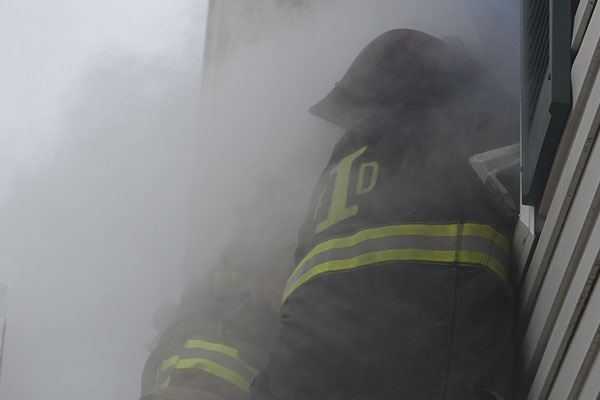
By Buster Cooper
A firefighter is trapped at the rear door of a commercial structure; he is low on air and is encountering intense heat. He calls a Mayday. Would you be able to quickly and efficiently perform the forcible exiting operation needed to rescue him? This article presents the knowledge and skills needed for this situation and emphasizes rotary saw and chain saw applications.
RELATED
SCBAs and Firefighter Survival
My Mayday: Lesson Learned Boosts Chance for Survival
Construction Concerns: Breaching Walls
Following are the basics you must consider when performing forcible exiting.
Size-Up
Begin sizing up the door before prior to the rescue. The best time to get a great look at rear exits is when riding around the district with your crew. The forcible exiting problem in this article is a heavily fortified rear door. Always ask yourself these following questions when sizing up a door: What type of door is it; there are differences in working with wood or metal doors. When working with a metal door, determine whether it is steel or reinforced with steel, and whether it swings inward or outward. When sizing up a wood door, determine if it is hollow, solid, or a panel door. Check the door to determine if the hinges are exposed or unexposed and if there are double doors. Next, ask these three questions: Can look for the lock. Are multiple locks visible? Are bolt heads visible from the front side of the door? You should be aware of the age of the occupancy because older structures usually are more heavily fortified at the rear door. Newer commercial structures, primarily strip malls, tend to have metal doors with a primary and a secondary basic locking mechanism.
Door Dissecting
After sizing up the door, determine how you will dissect it. If the door appears easy to dissect, conventional forcible exiting techniques will work. This involves using a set of irons or small hand tools for basic conventional forcing. Small hand tools that would work for this situation are the flathead ax, sledge hammer, halligan, pry bar, crow bar, handmade tools, or bolt cutters. If the door would be difficult or even extremely difficult to dissect, conventional forcible exiting will not work. You may have to use power tools.
Power Tools
Some examples of some basic power tools are reciprocating saws, fire service chain saws, and fire service rotary saws. When using rotary saws, the size of the cutting blade is an important factor in determining the success of your forcible exiting. Our training and experience have shown that the 14-inch blade works well for our department. Other considerations include the horsepower and revolutions per minute of the saw, the type of blades (what can or cannot cut through), and if the rotary saw is of an inboard or an outboard configuration. Our department uses aluminum oxide blades for training and the diamond tip for actual work. Inspect diamond-tip blades for hairline cracks between the cutting teeth and the bottom of the cooling ports. Blades with cracks should be immediately taken out of service because high heat can make the blade weak and possibly cause an accident. Ensure that the rotary saw is designed for the fire service. There are differences between saws designed for commercial use and for the fire service. Fire service saws have an enlarged pull handle for the firefighter’s glove, a spring-loaded safety switch, and a higher level of durability. Hence, this information should be used to purchase the appropriate saws so they will be available if firefighters become trapped at the rear door of a structure and need assistance from the crew on the outside.
Safety
Safety is a key component of a successful forcible exiting experience. Always take the appropriate safety precautions and wear the correct safety gear, including proper personal protective equipment with eye and ear protection.
Training Props/Material
You do not have to have a commercial grade forcible exiting training prop to practice forcible exiting training. You can go to any local metal scrap yard, salvage yard, or hardware store and get ½-inch rebar to represent dead bolts, ¼-inch flat steel to represent reinforced faceplates, and ½-inch wood dowels to assist in conventional forcible exiting using a set of irons (flathead ax, halligan). Numerous Web sites will give you examples of how to build a basic forcible exiting prop from these materials. To help in your forcible exiting training, consult firefighter line-of-duty death reports.
BIO
BUSTER COOPER, a 26-year veteran of the fire service, is the captain on Rescue 1 with the Conway (AR) Fire Department. He is the owner of 2 Alarm Fireground Training Inc. He is an adjunct instructor for the Arkansas Fire Academy and lead instructor for its forcible entry and ventilation hands-on programs. He has been an FDIC classroom presenter for the past five years.

